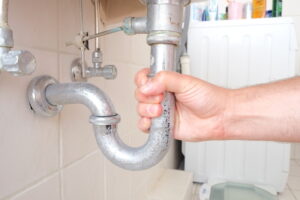If you’re looking for the best plumbing information from a skilled plumber in Winnetka, IL, you’ve come to the right people. Today, we’re going to look at a common questions people have about the plumbing in their home:
Why does the drainpipe under the sink have a curve in it?
Maybe you haven’t asked this out loud, but the thought has probably crossed your mind if you don’t already know the answer. We’ll explain in this post the important purpose of the drainpipe’s shape, as well as some problems you may run into with it.
Meet the P-Trap
That curved pipe section is known as the p-trap. If you turn your head on its side and look at the drainpipe, you’ll realize why. The pipe resembles the letter P without the back on the top. Plumbers work with stacks of these p-shaped pipes all the time—they’re one of the most fundamental pipe shapes used in all types of plumbing.
So what’s the purpose of this shape? It’s to trap water. Thanks to gravity, after water has run through the p-trap, some of it will remain in the curve afterward. This water creates a barrier between the drain and the rest of the drainage system of the house. That drainage system leads down to the sewer line and the sewer system, and the water in the p-trap prevents noxious sewer gasses from moving up the drainpipe and into the house.
You’ll discover the importance of the p-trap if one of them in your house ever dries up. Foul sewer odors will start to waft out of the drain. This often occurs in drain sinks in a house that don’t see much use, such as in a guest bathroom nobody uses. If you start noticing sewer smells in your home, check on the sinks. If you find one of the drains is the source of the odors, run water down the sink for a minute to restore the water in the p-trap. (If the odor persists, you may need to contact a plumber, as it’s possible the drain needs cleaning.)
The P-Trap Can Sometimes Go Wrong
Dried p-traps aren’t the only time that a p-trap can end up creating problems with your plumbing. Unfortunately, the same power of gravity that traps water can also lead to trapping other things, leading to clogging. Hair can easily get stuck in the p-trap for bathroom sinks and showers, and once hair starts to accumulate in the p-trap, it catches even more hair and leads to rapid build-up. Removing a hair clog from a drain can be tricky. You can try using a drain auger, but in some situations you may need professional plumbers to use special equipment to open up the drain.
Please don’t use drain cleaning chemicals to get rid of p-trap clogs, because another problem that p-traps can create is trapping these acidic chemicals. The chemicals will remain in the pipe and begin to eat away at piping material and speed up corrosion.
You can always trust our plumbers for help when you have drain clogs or you need repairs done for your drains.
For expert plumbing service, installations, or maintenance contact Reliance Plumbing Sewer & Drainage, Inc. Our knowledgeable plumbers serve the North Shore and Northwest Chicago suburbs. Rely on Reliance!

